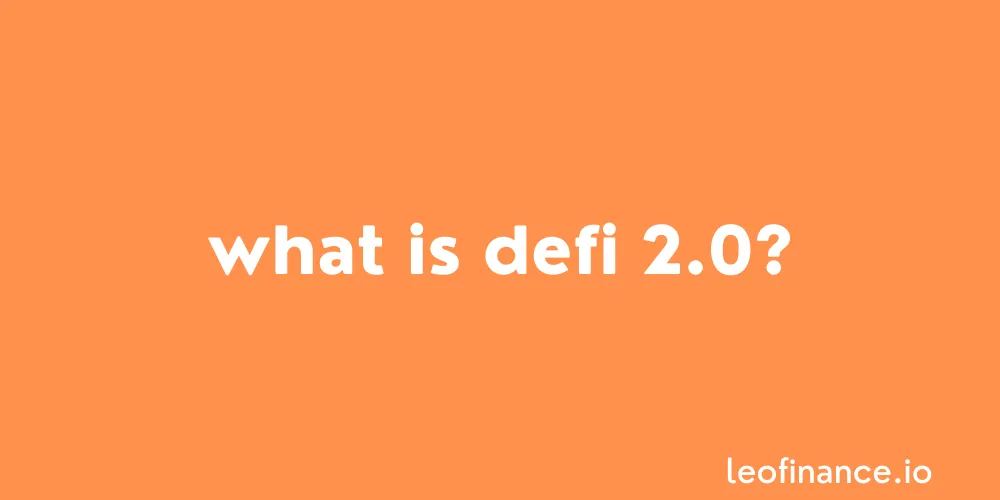
Direct from the desk of Dane Williams.
Discover what is DeFi 2.0 and why PolyCub is one of the best DeFi 2.0 projects to invest in.
DeFi 2.0 is the second wave of DeFi platforms, aimed at improving on and correcting problems faced by the trailblazing first generation.
In this blog we’ll look at DeFi 2.0 through our own PolyCub tinted lens and talk about how these platforms build upon and solve the problems faced in DeFi 1.0.
Let’s dive straight in!
What is DeFi?
Before we get into the concept of DeFi 2.0, let’s first start off by taking a look at DeFi itself.
The term DeFi is short for decentralised finance and aims to solve the issues faced by traditionally centralised finance, usually using a blockchain based solution.
The main issues surrounding the centralisation of our finances include:
- Trust
- Security
- Autonomy
Basically, the fact that you always have to trust and rely on a third party somewhere down the line.
Your finances are not actually your finances, because they’re in the custody or control of someone else.
DeFi therefore takes the concept of trusting a human third party and replaces them with trusting lines of code in the form of smart contracts.
Problems facing DeFi
But you can’t just decentralise and hope for the best.
There was always going to be, and most certainly are huge issues facing the first iteration of DeFi platforms.
Take the basic concept of liquidity pools as an example.
Liquidity Pools
Liquidity pools are one of the most popular aspects of DeFi, allowing you to earn fees in exchange for staking your tokens in pairs that facilitate permissionless trading.
But providing liquidity is not free from risk.
If the price of one token compared to the other changes, liquidity providers will lose money.
This concept is what’s known as impermanent loss and is probably the biggest risk or drawback facing DeFi.
So let’s go deeper.
Scalability
Another common drawback facing DeFi is the industry’s ability to scale into a mainstream solution.
With Ethereum based DeFi applications leading the charge, there’s no wonder that transaction speeds and gas fees are a huge scaling roadblock.
When you throw in the lack of truly decentralised networks to run these DeFi applications or to source third-party information from, scalability issues are clear to see.
These are just a few of the main drawbacks of DeFi that DeFi 2.0 aims to solve.
What is DeFi 2.0?
As mentioned above, DeFi 2.0 aims to improve upon and correct the problems faced by the first wave of DeFi platforms.
DeFi 2.0 aims to make it easier for people to get involved in decentralised finance and free them from the shackles of centralisation.
A concept that even those in the west are starting to see poses a significant threat.
Could your money be next?
Solving some of the initial drabacks of DeFi in DeFi 2.0 matters because it can provide free and open access to financial services, without compromising on risk.
If DeFi 2.0 platforms can limit risk and become truly decentralised, self-sustaining financial platforms, then the extremely limiting global financial backbone that we have become accustomed to accepting, will be turned on its head.
By successfully providing safe, profitable incentives for LPs, lenders and borrowers, then DeFi 2.0 will literally allow anyone to not only participate, but receive life changing benefits.
How DeFi 2.0 changes the game
While the risk of impermanent loss while providing liquidity will always remain, DeFi 2.0 offers mechanisms to limit and in some cases completely offset this risk.
DeFi 2.0 protocols can actually provide insurance against impermanent loss, thus providing greater incentives to provide permissionless liquidity to traders.
Issues around a lack of liquidity can be solved by cross-blockchain bridges.
Just like our very own LeoBridge connects Hive, Ethereum, BSC, Polygon and beyond, this helps to ensure deep pools of liquidity are accessible on demand.
All without permission.
But one of the coolest ways that DeFi 2.0 solves problems faced in the first generation of decentralised finance, is by building protocol-controlled value mechanisms.
This is the concept of allowing DeFi 2.0 protocols to use bonding mechanisms to gain and maintain their own liquidity.
Something we see playing out before our very eyes right now on PolyCub.
Protocol controlled value in PolyCub
POLYCUB behaves differently to first generation DeFi yield farm tokens in that it is deflationary.
Until the max supply number of 26,000,000 is reached, the POLYCUB token supply will be halved every month.
From the launch of the PolyCub platform, a Protocol Controlled Value (PCV) is built into and being generated by the platform.
This value is being generated by users who choose to harvest their rewards early as well as other mechanisms like LP Bonding and management fees.
The PolyCub PCV treasury is a key DeFi 2.0 tool to change the decentralised finance game forever.
As the PCV grows, the RFV (Risk-Free Value) of POLYCUB grows as well.
What this does is essentially place a price floor or deterministic value on the price of the token.
This is because theoretically, POLYCUB can always be redeemed for the PCV.
Using the team’s example, if there is $1m in PCV, then we know that POLYCUB's RFV is the current supply / $1,000,000 USD.
Since the PCV itself is pooled as TVL in the Kingdoms, the TVL of POLYCUB grows endlessly and so does the Risk-Free Value of POLYCUB.
The future of DeFi 2.0
Projects like PolyCub that implement aspects of DeFi 2.0 show that the future of the entire industry is moving in the right direction.
Innovation is going on all around us and we’re on the cutting edge right here as members of the LeoFinance community.
Just remember that while DeFi 2.0 is designed to limit the financial risks present in DeFi 1.0 the realm is still far from mainstream.
I challenge you to ask a regular Joe on the street whether they understand the concepts discussed above and I guarantee that your odds of getting an answer are less than 1%.
For this reason, DeFi 2.0 still has a long way to go before reaching its full potential.
But boy is it exciting to be strapped in and along for the ride here on LeoFinance.
So what are you waiting for?
Buy POLYCUB, provide liquidity and see what the fuss is all about yourself.
Best of probabilities to you.
Posted Using LeoFinance Beta
Return from What is DeFi 2.0 and how does it change the game? to forexbrokr's Web3 Blog

